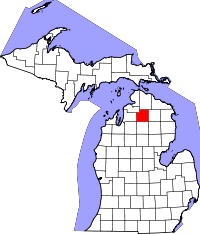Charlton Township, Michigan
| Charlton Township, Michigan | |
|---|---|
| Township | |
| Nickname(s): Joberg | |
 Charlton Township, Michigan Location within the state of Michigan | |
| Coordinates: 44°57′10″N 84°24′58″W / 44.95278°N 84.41611°WCoordinates: 44°57′10″N 84°24′58″W / 44.95278°N 84.41611°W | |
| Country | United States |
| State | Michigan |
| County | Otsego |
| Area | |
| • Total | 102.2 sq mi (264.8 km2) |
| • Land | 100.3 sq mi (259.9 km2) |
| • Water | 1.9 sq mi (4.9 km2) |
| Elevation | 1,371 ft (418 m) |
| Population (2000) | |
| • Total | 1,330 |
| • Density | 13.3/sq mi (5.1/km2) |
| Time zone | Eastern (EST) (UTC-5) |
| • Summer (DST) | EDT (UTC-4) |
| FIPS code | 26-14840[1] |
| GNIS feature ID | 1626063[2] |
Charlton Township is a civil township of Otsego County in the U.S. state of Michigan. The population was 1,330 at the 2000 census.
Communities
There are no incorporated municipalities in the township.
- Johannesburg is an unincorporated community on M-32. The ZIP Code is 49751, which serves much of Charlton Township.
- Vienna Corners is an unincorporated community on M-32 on the eastern boundary of the township.
Geography
According to the United States Census Bureau, the township has a total area of 102.2 square miles (265 km2), of which, 100.3 square miles (260 km2) of it is land and 1.9 square miles (4.9 km2) of it (1.85%) is water.
History
Charlton Township is a community rich in history, as it emerged with lumbering and milling operations in 1875. Johannesburg was incorporated in 1901, home to the lumbering company of Johannesburg Mfg. Co., operated by the Sailing, Hanson and Michelson families. The town was named after Johanna Hanson, who is the wife of the president of the company. The company was responsible for much of the construction in the small town, including the development of a branch railroad line, which served as a lifeline for the town. At its peak, Johannesburg was a bustling community of 700. By 1929, 71 lumbering operations had ceased. [3]
Demographics
As of the census[1] of 2000, there were 1,330 people, 552 households, and 416 families residing in the township. The population density was 13.3 per square mile (5.1/km²). There were 1,391 housing units at an average density of 13.9 per square mile (5.4/km²). The racial makeup of the township was 98.42% White, 0.30% Native American, 0.15% Asian, and 1.13% from two or more races. Hispanic or Latino of any race were 0.23% of the population.
There were 552 households out of which 24.6% had children under the age of 18 living with them, 66.8% were married couples living together, 4.2% had a female householder with no husband present, and 24.6% were non-families. 19.9% of all households were made up of individuals and 8.9% had someone living alone who was 65 years of age or older. The average household size was 2.41 and the average family size was 2.74.
In the township the population was spread out with 21.5% under the age of 18, 5.3% from 18 to 24, 24.2% from 25 to 44, 32.2% from 45 to 64, and 16.8% who were 65 years of age or older. The median age was 44 years. For every 100 females there were 109.8 males. For every 100 females age 18 and over, there were 108.4 males.
The median income for a household in the township was $36,536, and the median income for a family was $41,200. Males had a median income of $32,578 versus $21,574 for females. The per capita income for the township was $20,211. About 3.3% of families and 6.5% of the population were below the poverty line, including 7.7% of those under age 18 and 3.2% of those age 65 or over.
Johannesburg
The unincorporated community of Johannesburg is the home of the Johannesburg-Lewiston Area Schools, which also includes the unincorporated census-designated place of Lewiston in Montmorency County. Johannesburg also includes two churches, two popular restaurants (The Old Depot and Paul's Pub), a small market and gas station, and a war veterans memorial, and, unusually for an unincorporated community, hosts a popular July 4 fireworks show every year.
References
External links
| |||||||||||||||||||||||||||||
